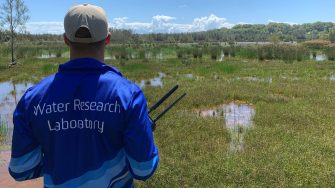- UNSW
- ...
- Water Research Laboratory
- Our research
- Big Swamp restoration project
- Home
- About us
-
Our research
- Australian coastal observation network
- Big Swamp restoration project
- Cars in floods: Vehicle stability testing for flood flows
- Caseys Beach seawall upgrade
- Climate change in NSW estuaries
- Clybucca monitoring
- Clybucca Wetlands management options study
- Coastal adaptation needs for extreme events and climate change, Avarua, Rarotonga, Cook Islands
- CoastSat
- CoastSnap
- Cold water pollution: A review
- Eurobodalla Shire Council coastal hazard assessment
- Hunter River water quality model
- Hunter scoping study
- Kingscliff seawall design
- Manly coastal hazard assessment
- NSW coastal floodplain prioritisation project
- Oceanlinx wave energy system physical modelling
- Oyster reef restoration project
- Physical modelling of Bounty Bay breakwater, Pitcairn Island
- Port Fairy coastal hazard assessment
- Scrivener Dam physical model
- The mystery of Thirlmere Lakes
- Tomago Wetland monitoring
- Tomago Wetland restoration project
- Tube fishway project
- Tuckean Swamp drainage options study
- Yeramba Lagoon restoration
- Facilities & equipment
- Our expertise
- News
- Contact us

Year: 2012 - ongoing
A two year collaborative project has turned a large acidic landscape into a new tidal wetland. WRL, working with Greater Taree City Council and WetlandCare Australia, have undertaken a comprehensive scientific study to identify and remediate high priority acid farmlands on the Big Swamp floodplain, near Taree, NSW. For many years, the site has been listed as one of the three worst ASS hotspots in NSW.
Big Swamp is the local name for a series of drained agricultural floodplains located on the Manning River estuary on the mid-north coast of NSW. The Big Swamp floodplain was historically a large brackish backswamp known for its abundant bird populations. Over the past 110 years, the system has undergone major hydrologic modifications, due to the construction of an extensive floodplain drainage network system and floodgates.
The combination of extensive drainage and sulfidic subsoils has ac...
Big Swamp is the local name for a series of drained agricultural floodplains located on the Manning River estuary on the mid-north coast of NSW. The Big Swamp floodplain was historically a large brackish backswamp known for its abundant bird populations. Over the past 110 years, the system has undergone major hydrologic modifications, due to the construction of an extensive floodplain drainage network system and floodgates.
The combination of extensive drainage and sulfidic subsoils has acidified the soil and adjacent waters. While the entire site (approximately 2,000 hectares below 2 m AHD) is now acidic (pH<4.0), rainfall events increase acid discharges creating large acid plumes throughout the lower estuary. These plumes impact the once thriving oyster industry and decrease overall primary production.
A detailed surface and groundwater study has been underway within the Big Swamp catchment since mid-2012. The study has identified acid hotspots, transport pathways, flooding issues and nominated high priority areas for remediation.
In January-February 2013, a significant flooding event occurred in the lower Manning River estuary forming large acidic plumes (pH<2.7). The acid plume dynamics within the estuary were extensively monitored to assess acid impacts and saline dynamics. The final report from the study outlined key areas to restore, monitoring strategies and detailed on-ground works including drain infilling, land reshaping and wetland creation.
In late-2013, approximately 670 hectares of private properties located within prioritised zones were acquired by Council through Caring for our Country funding. From July to December 2013 the on-ground works were implemented onsite and post-remediation monitoring is underway.
Based on Council’s preliminary monitoring, the water quality has significantly improved and the wetland vegetation is recovering. The on-ground works are designed to ensure that the new landscape will naturally evolve towards a dynamic saltwater/freshwater wetland.
Further land acquisition and on-ground works were undertaken in 2014 through funding secured by Council and WRL. This has expanded the remediated area to the north-east of the site and targeted additional high priority acid contributing drains.
To date, the Big Swamp project has transformed over 700 hectares of degraded landscapes into functioning wetlands, including 80 hectares of new tidal wetlands. It has also elevated ground water levels above the acidic soil layer and re-inundated over 620 hectares. The project’s success was recognised in 2015 with a prestigious Green Globe Award.



